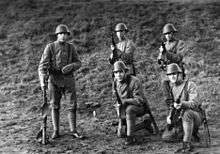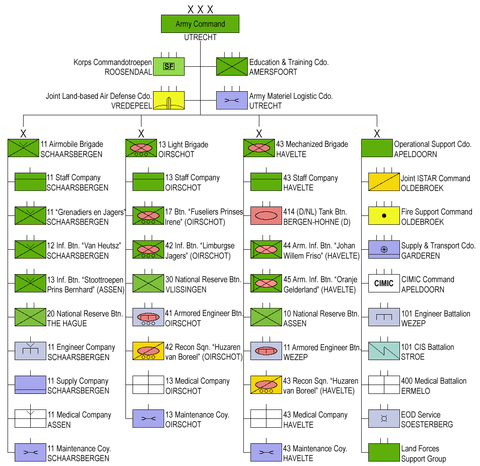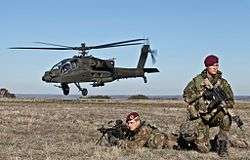Royal Netherlands Army
| Royal Netherlands Army | |
|---|---|
 Logo of the Royal Netherlands Army | |
| Founded | January 9, 1814 |
| Country |
|
| Allegiance |
|
| Type | Army |
| Size | 21,500 active full time and part time personnel |
| Part of |
|
| HQ | Kromhout kazerne (Utrecht) |
| Engagements |
Eighty Years' War Dutch–Portuguese War Dano-Swedish War (1658–1660) Franco-Dutch War Nine Years' War War of the Spanish Succession French Revolutionary Wars Anglo-Russian invasion of Holland Battle of Friedland Peninsular War French invasion of Russia Hundred Days Battle of Waterloo Belgian Revolution World War II Korean War Indonesian National Revolution Cold War Dutch New Guinea Dispute Iraq War War in Afghanistan |
| Commanders | |
| Commander | Lieutenant General Leo Beulen[1][2] |
| Deputy commander | Major General Marc van Uhm |
| Insignia | |
| Flag |
 |
The Royal Netherlands Army (Dutch: Koninklijke Landmacht (KL), "Royal Army") is the land forces element of the military of the Netherlands.
The Royal Netherlands Army was raised on 9 January 1814—however, its origins date back to 1572, when the so-called Staatse Leger was raised. Therefore, the Netherlands has one of the oldest standing armies in the world, dating back to the 16th century. It fought during the Napoleonic Wars, World War II, the Indonesian War of Independence, Korean War, and served with NATO on the Cold War frontiers in Germany from the 1950s to the 1990s.
Since 1990, the army has deployed to the Iraq War from 2003 and the War in Afghanistan, as well as a number of United Nations peacekeeping deployments, notably with UNIFIL in Lebanon, and UNPROFOR in Bosnia-Herzegovina in 1992–1995.
2 of 3 Dutch Army Brigades are now under German Command. In 2014 the 11th Airmobile Brigade, was integrated into the German Division of fast forces (DSK). Also the Dutch 43rd Mechanized Brigade, will be integrated into the 1st Panzer Division (Bundeswehr) of the German army. with the integration starting at the beginning of 2016, and the unit becoming operational at the end of 2019. The Dutch-German military cooperation are seen as an example for setting up a European defense union.[3][4]
Short history
Republic and French period, 1572 to 1814

The Royal Netherlands Army was raised on 9 January 1814, but its origins date back to 1572, when the so-called Staatse Leger was founded. Therefore, the Netherlands operates one of the world's oldest standing armies, dating back to the 16th century. This army of the Dutch Republic was one of the best organised, and well trained armies of the 17th and early 18th century, and saw actions in the Eighty Years War, the Dano-Swedish War (1658–1660), the Franco-Dutch War, the Nine Years War, the War of Spanish Succession, the War of Austrian Succession, and the French Revolutionary Wars until the French conquered the Netherlands in early 1795.
The Staatse Leger was replaced by the army of the Batavian Republic in 1795, which in turn was replaced by the army of the Kingdom of Holland in 1806. It fought alongside the French in the Anglo-Russian Invasion of Holland in 1799 and several campaigns in Germany, Austria and Spain between 1800 and 1810. Most notable were the engagements of the Horse Artillery (Korps Rijdende Artillerie) at the Battle of Friedland in 1807, the capture of the city of Stralsund in 1807 and 1809 and the participation of the Dutch brigade in the Peninsular War between 1808 and 1810. The independent army was disbanded in 1810 when Napoleon decided to 'reunite' Holland into France ("La Hollande est reunie à l'Empire"). The army units became part of the Grande Armée. The present day French 126th Infantry Regiment has Dutch origins. Dutch army elements participated in the French invasion of Russia in 1812. Most notable were the actions of the Pontonniers company under Captain Benthien at the Berezina River (Battle of Berezina). New research points out that, contrary to what is currently believed, approximately half of the Dutch contingent of the Grande Armée survived the Russian Campaign.[5]
Kingdom of the Netherlands, 1814 to present
An independent Dutch army was resurrected by the new Kingdom of the United Netherlands in 1814, following the Orangist uprising against Napoleonic rule in 1813. This new force, the Netherlands Mobile Army, formed an integral part of the allied army during the Hundred Days Campaign that culminated in the Battle of Waterloo. Units such as Baron Chassé's were key in securing victory for the allied army. Since 1814, (elements of) the army have been involved in several military conflicts (Waterloo campaign 1815, several colonial wars 1825–1925, and the Belgian Revolution 1830–1832.
At the beginning of the Second World War, the I Corps was the force strategic reserve and was located in the Vesting Holland, around The Hague, Leiden, Haarlem and in the Westland. The Royal Netherlands Army was defeated in May 1940 and only began to rise again with the formation of the Princess Irene Brigade Group in exile. In the Far East, the Royal Netherlands East Indies Army was defeated by the Japanese in 1942; few elements managed to escape. Today's army grew out of the wartime force, starting with the liberation of parts of the Netherlands in 1944; the Dutch had plans to contribute a 200,000 strong army to the defeat of Germany and Japan.[6]
The army then fought in the Indonesian War of Independence 1945–1949, in Korea in 1950-53, and the war with Indonesia over New Guinea, 1960–1962. The Royal Netherlands Navy and an army battalion were sent to Korea between 1950 and 1954. In total, 3,972 Soldiers were sent to fight the war in Korea, 123 died in combat.
The I (Netherlands) Corps stood watch alongside its NATO allies in Germany during the Cold War. The corps consisted of three divisions during the 1980s, the 1st, 4th, and 5th (reserve) divisions.[7] It was part of the NATO Northern Army Group. The corps's war assignment, as formulated by Commander, Northern Army Group (COMNORTHAG), would be to:[8]
- Assume responsibility for its corps sector and relieve 1st German Corps forces as soon as possible.
- Fight the covering force battle in accordance with COMNORTHAG's concept of operations.
- In the main defensive battle: (1) hold and destroy the forces of the enemy's leading armies conventionally as far east as possible, maintaining cohesion with 1 (GE) Corps; (2) in the event of a major penetration affecting 1 (NL) Corps sector, be prepared to hold the area between the roads A7 and B3 and to conduct a counterattack according to COMNORTHAG's concept of operations.
- Maintain cohesion with LANDJUT and secure NORTHAG's left flank in the Forward Combat Zone.
During the early 1990s I (NL) Corps was reduced to the First Division 7 December, which became part of I. German/Dutch Corps, and then later the division headquarters itself was disbanded.
Since the end of the Cold War, the army concentrates on peace-keeping and peace-enforcing operations and has been involved in several operations (in Lebanon between 1979 and 1985, and the former Yugoslavia (Bosnia-Herzegovina, Croatia, Macedonia and Kosovo) 1991–present, but also in Cambodia 1992–1994, Haiti 1995–1996, Cyprus 1998–1999, Eritrea and Ethiopia 2001, and most recent in Iraq 2003–2005, Afghanistan 2002–2010 and Chad 2008–2009).
568 AIFV (YPR-765) infantry fighting vehicles were in service until June 2012, while of a total of 445 Leopard 2 MBTs originally purchased, 114 tanks and 1 turret were sold to Austria, 100 to Canada, 57 to Norway, 1 driver training tank and 10 turrets to Germany and 38 to Portugal (1 driver training tank). On April 8, 2011 the Dutch Ministry of Defense dissolved the last tank unit and sold the remaining Leopard tanks due to large budget cuts.[9] On May 18, 2011 the last Leopard 2 fired the final shot at the Bergen-Hohne Training Area.[10]
Lebanon
Dutch army troops have deployed to Lebanon as part of an international protection force since 1979 War in Lebanon, 1979–1985 UNIFIL. Of the 9,084 soldiers who served in Lebanon, 9 soldiers died. Among the units that contributed troops to Dutchbat South Lebanon was 44 Armoured Infantry Battalion (44 painfbat) from the Regiment Infanterie Johan Willem Friso. All 9,084 Soldiers received the medal for peace keeping under war circumstances.
Bosnia-Herzegovina
Dutch army troops have deployed to Bosnia-Herzegovina as part of a United Nations protection force since 1992 and criticized by human rights organizations due to the role during Srebrenica massacre in which 8.000 Bosniaks were killed in Bosnia.[11]
Kosovo
Dutch army troops have deployed to Kosovo as part of the NATO Kosovo Force since 1999.
Iraq
A contingent of 1,345 troops (comprising Landmacht and Dutch Marines, supported by Royal Netherlands Air Force helicopters) was deployed to Iraq in 2003, based at Camp Smitty near As Samawah (Southern Iraq) with responsibility for the Muthanna Province, as part of the Multinational force in Iraq. On June 1, 2004, the Dutch government renewed their stay through 2005. The Netherlands pulled its troops out of Iraq in March 2005, leaving half a dozen liaison officers until late 2005. The Dutch Government reportedly turned down an Iraqi Government request to extend the Dutch contingent for another year. The Netherlands lost 2 soldiers in separate attacks. On 18 April 2008 the son of the Army commander, Lieutenant Dennis van Uhm, was one of the two killed by a road side explosion.
Afghanistan
In mid 2006, Dutch Special Forces Korps Commandotroepen teams deployed successfully to Tarin Kowt in Afghanistan, to lay the ground for the increasing numbers of engineers who were building a vast base there. At the same time other special forces units from other nations deployed throughout the area, and worked closely together in this volatile area. By August 2006 the Netherlands deployed the majority of 1,400 troops to Uruzgan province at southern Afghanistan at Tarin Kowt (1,200), at Kamp Holland, and Deh Rahwod (200). The soldiers of Task Force Uruzgan were mostly from the Regiment Van Heutsz, supplemented with soldiers from 44 Pantserinfanteriebataljon Regiment Johan Willem Friso and the 42 Tankbataljon Regiment Huzaren Prins van Oranje. PzH 2000 self-propelled artillery pieces were deployed and used in combat for the first time. Since 2006, Dutch forces were involved in some of the more intensive combat operations in southern Afghanistan, including Operation Medusa and the Battle of Chora. As of 10 August 2008, The Netherlands had a total of 1,770 troops in Afghanistan not including special forces troops.
Mali
Special forces are operating in the UN-mission Minusma in Mali, their primary task is to gather intell about local islamic groups and to protect the people of Mali against radical islamic groups. Together with the France Armed Forces, the Netherlands are the leading country in this UN-mission.
Structure

The core fighting element of the army consists of three brigades: 11th Airmobile Brigade, 13th Light Brigade and 43rd Mechanized Brigade. The number of full-time professional personnel is 21,500.[12] The Royal Netherlands Army is a volunteer force; compulsory military service has not been abolished but has been suspended. The other three services (Royal Netherlands Navy; Royal Netherlands Air Force and the Royal Marechaussee) are fully volunteer forces as well.
Union
Unlike many other military organizations, Dutch Army soldiers are represented by various unions. The four main unions are:
- General Christian Union for Military personnel (ACOM);
- General Federation for Military Personnel (AFMP)
- Joint Officers Associations | Mid- & Highlevel Civilian Personnel (GOV|MHB);
- Association for Civil and Military personnel (VBM).
Units
Cavalry
- Regiment Huzaren Van Boreel, former 4th Hussars Regiment (formed in 1813, origins date back to 1585) - Reconnaissance/ISTAR
Prior to 2012, the army also included armoured regiments equipped with main battle tanks. One of these, the Regiment Huzaren Prins Alexander (former 3rd Hussar Regiment), was disbanded in November 2007 due to budget cuts. The other two, the Regiment Huzaren Van Sytzama (former 1st Hussar Regiment) and the Regiment Huzaren Prins van Oranje (former 2nd Hussar Regiment) were disbanded, along with the army's full armoured capability, in 2012 as a result of further cuts to the Dutch defence budget.[13]
Infantry



Each infantry regiment of the Royal Netherlands Army consists of a single battalion. The current order of battle includes a total of seven infantry battalions - of these, two are classed as foot guards and the remainder as line infantry:
- Foot Guards
- Garderegiment Grenadiers en Jagers, formed in 1995 through amalgamation of two regiments (formed 1829)
- Garderegiment Fuseliers Prinses Irene, formed in 1941
- Line Infantry
- Regiment Infanterie Johan Willem Friso, former 1st and 9th Infantry Regiment (formed in 1813)
- Regiment Infanterie Oranje Gelderland, former 5th and 8th Infantry Regiment (formed in 1813)
- Regiment Limburgse Jagers, former 2nd, 6th and 11th Infantry Regiment (formed in 1813)
- Regiment Van Heutsz, former Netherlands East Indies Army, formed in 1832 (origins date back to 1814)
- Regiment Stoottroepen Prins Bernhard, formed in 1944 from several resistance formations
- Korps Nationale Reserve(formed in 1948)
The 4th Infantry Regiment (disbanded 1950) and the Regiment Infanterie Menno van Coehoorn (former 3rd Infantry Regiment, disbanded in 1995) and the Regiment Infanterie Chassé (former 7th and 10th Infantry Regiment, disbanded 1995) remain disbanded.
The staff support companies of 11th Air Mobile Brigade, 13th Motorised Brigade and 43rd Mechanized Brigade are part of the Garderegiment Grenadiers en Jagers, the Garderegiment Fusiliers Prinses Irene and Regiment Infanterie Johan Willem Friso respectively.
Mechanised Infantry
- 44 Pantserinfanteriebataljon Regiment Infanterie Johan Willem Friso
- 45 Pantserinfanteriebataljon Regiment Infanterie Oranje Gelderland
Motorised Infantry
- 17 Infanteriebataljon Garde Fuseliers Prinses Irene
- 42 Infanteriebataljon Regiment Limburgse Jagers
Air Assault Infantry
- 11 Infanteriebataljon Garde Grenadiers en Jagers
- 12 Infanteriebataljon Regiment Van Heutsz
- 13 Infanteriebataljon Regiment Stoottroepen Prins Bernhard
National Reserve (light Infantry)
- 10 Natresbataljon
- 20 Natresbataljon
- 30 Natresbataljon
Special forces
- Korps Commandotroepen formed in 1942 - Special Forces unit
Support arms
- Korps Veldartillerie, formed in 1677 - Field Artillery
- Korps Rijdende Artillerie, formed in 1793 - Horse Artillery
- Korps Luchtdoelartillerie, formed in 1917 - Air Defence Artillery
- Regiment Genietroepen, formed in 1748 - Engineers
- Regiment Verbindingstroepen, formed in 1874 - Communications
Air Defence
Located at Lieutenant General Best Barracks, formerly known as De Peel Air Base.
Services
- Regiment Bevoorradings-en Transporttroepen - Transport and Logistics
- Regiment Geneeskundige Troepen - Medical
- Regiment Technische Troepen - Electrical/Mechanical Engineers
- Dienstvak Technische Staf - Technical engineers
- Dienstvak Militair Juridische Dienst - Legal service
- Dienstvak Militair Psychologische en Sociologische Dienst - Psychological and Sociological service
- Korps Militaire Administratie - Administration
- Koninklijke Militaire Academie - Royal Military Academy
- Koninklijke Militaire School - Royal Military School
- LO/Sportorganisatie - Physical training and Sports
Military academy
The military academy of the Royal Netherlands Army is the Koninklijke Militaire Academie in Breda.
Army reserve
Korps Nationale Reserve - three mixed regional oriented battalions (mainly infantry with a light role), similar to UK Territorial Army now called the Army Reserve. The battalions are part of the 11th Airmobile, 13th Light and 43rd Mechanized Brigade since 2011.
Bi-national army corps
The Netherlands and Germany work together in a Bi-national Army Corps structure, the I. German/Dutch Corps. This is a rapid deployable Army Corps headquarters that can be deployed in the frame of the NATO Response Force. The permanent elements of this corps are a bi-national Staff Support Battalion and a bi-national Communications and Informations Battalion. The Staff Support Battalion consists of a bi-national staff support company and a logistics company. The battalion is based at Münster (Germany) and Eibergen (Netherlands).
Equipment
See also
References
- ↑ Commandant Landstrijdkrachten (in Dutch), Ministry of Defence. Retrieved 27 March 2016.
- ↑ "Leo Beulen gaat landmacht leiden" (in Dutch), NRC Handelsblad, 2016. Retrieved 27 March 2016.
- ↑ http://www.defensenews.com/story/defense/naval/2016/02/04/bundeswehr-sea-battalion-dutch-navy-integration/79845430/
- ↑ http://www.janes.com/article/54636/dutch-mechanized-brigade-to-be-integrated-into-german-panzer-division
- ↑ https://www.academia.edu/6264505/The_Dutch_Experience_and_Memory_of_the_Campaign_of_1812_a_Final_Feat_of_Arms_of_the_Dutch_Imperial_Contingent_or_the_Resurrection_of_an_Independent_Dutch_Armed_Forces
- ↑ Isby and Kamps, 1985, 317
- ↑ Structural details in 1985 can be seen at http://www.orbat85.nl/, accessed April 2012.
- ↑ a-d quoted from Felius, Einde oefening. Infanterist tijdens de Koude Oorlog (Arnhem: Uitgeverij Quintijn, 2002), 305, via Hans Boersma, I (NL) Corps, accessed 4 April 2012
- ↑ http://www.defensie.nl/actueel/nieuws/2011/04/08/46180709/Defensie_hard_getroffen_door_bezuinigingen_video
- ↑ dvhn.nl (Dutch)
- ↑ "Court Says the Dutch Are to Blame for Srebrenica Deaths".
- ↑ http://www.defensie.nl/actueel/defensiebladen/de_landmacht/2011/46186412/Landmacht_nr_6_september_2011
- ↑ "'Nederland krijgt leger zonder tanks". nu.nl. 17 March 2011. Retrieved 2 May 2012.
External links
| Wikimedia Commons has media related to Army of the Netherlands. |
- Royal Netherlands Army, official website
